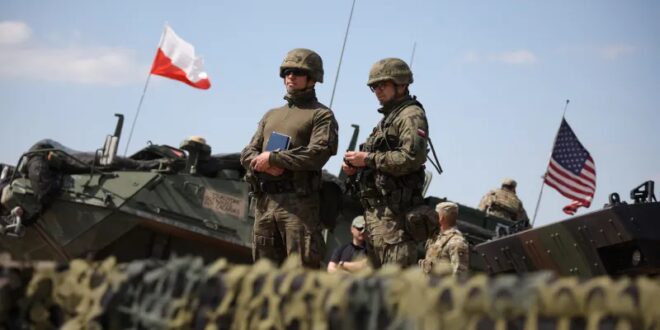Debating an “Asia First” Approach
Europe Must Step Up
As French President Emmanuel Macron travelled back from Beijing in April, he sparked an uproar. Speaking to reporters, Macron stated that European and U.S. interests were diverging, particularly in their approaches toward Asia. “The worst thing for Europe,” he said, “would be just when we have finally managed to clarify our strategic position, we end up pulled into a world of crises that are not our own.”
Washington greeted Macron’s comments with dismay. The Biden administration has been at pains to project an image of Western unity under stable U.S. leadership. However, the French president’s remarks intensified the simmering debate over whether the United States should seek to pull European states into its competition with China, or should instead reduce its leading role in the defense of Europe in order to prioritize security needs in Asia.
For many analysts in Washington, the latter move would be a costly mistake. As the political scientist Michael Mazarr recently wrote in Foreign Affairs (“Why America Still Needs Europe,” April 17), significantly downgrading the United States’ defense commitments in Europe would “validate the grim picture that China and Russia now paint of a United States that is pitilessly self-interested and transactional, and would severely undermine the United States’ painstaking attempts to build a reputation as that rare great power that offers something to the world other than naked ambition.”
This is a common refrain among those who believe that any meaningful U.S. military drawdown from Europe—most likely involving other states stepping up to shoulder the lion’s share of the defense burden—would sever U.S. ties with the continent and even the world. Pulling back, they argue, is prohibitively risky, would save little money, and could destroy broader cooperation between the United States and Europe.
This concern is overblown. It rests on excessive optimism about the United States’ ability to deter both China and Russia indefinitely and on unwarranted pessimism about the trajectory of a more capable Europe. In reality, countries on both sides of the Atlantic would benefit from transferring most of the responsibility for defending Europe to Europeans themselves, allowing the United States to shift to a supporting role. The result is more likely to be a balanced and sustainable transatlantic partnership than a transatlantic divorce. The alternative, meanwhile, is to stick with a deteriorating status quo that suppresses Europe’s defense capabilities and asks ever more of Washington.
SPREAD TOO THIN?
Arguments for trimming the United States’ commitments to Europe are nothing new. In 1959, U.S. President Dwight Eisenhower complained that, by refusing to replace U.S. military forces with their own, European members of NATO were coming close to “making a sucker out of Uncle Sam.” Policymakers in successive administrations, both Republican and Democrat, voiced similar concerns. Recently, however, the debate has been reshaped by the alignment of “Asia first” hawks with foreign policy realists who favor strategic restraint. The hawks, preoccupied with the rise of China, fear that U.S. commitments in Europe could undermine priorities in Asia. The realists, on the other hand, have long argued for U.S. retrenchment from Europe on geopolitical and budgetary grounds.
The case for European defense is straightforward: with the rise of China and the intensification of the Chinese-U.S. rivalry, the United States gains little and sacrifices much by serving as the primary security provider for European countries that can afford to fund their own defense against Russia. If anything, the poor battlefield performance of Russian forces in Ukraine suggests that U.S. retrenchment might be more achievable than previously thought.
Mazarr challenges this assessment. He claims that U.S. commitments to Europe and Asia entail few practical tradeoffs and that a U.S. drawdown in Europe would save hardly any money. He arrives at these conclusions by assuming that what matters is whether the United States’ peacetime military presence is sustainable. The prospect of a deterrence failure in Europe or Asia is largely excluded from his analysis.
The United States is not capable of conducting full-scale operations against China and Russia simultaneously.
Mazarr is probably correct that a significant peacetime presence in both theaters is feasible in the short term. But war in at least one region is a real and growing possibility that cannot be discounted. Direct conflicts with China or Russia have become likelier in recent years, and there is a sizable gap between the rhetoric of U.S. leaders and the country’s military capabilities. Although policymakers talk about deterring both China and Russia indefinitely, the 2018 National Defense Strategy effectively abandoned plans for the United States to maintain forces sufficient to fight wars in two regions—let alone against two major powers—at once.
Today, the United States military is not capable of conducting full-scale operations against China and Russia simultaneously. The United States’ adversaries know this, and the knowledge may embolden them to test Washington’s commitments. Peacetime deterrence and wartime defense, in other words, are connected. Inadequate defenses weaken deterrence, so plans for peace cannot be separated from plans for war. Recognizing the growing risk since Russia’s February 2022 invasion of Ukraine, U.S. allies in both Europe and Asia have called on Washington to devote more resources to their regions.
We are less worried than some Asia firsters that China intends to invade Taiwan in the immediate future, so long as Taiwan does not declare independence and the United States does not treat the island as permanently separate from mainland China. Nevertheless, it would be foolish to ignore the medium- and long-term risks. A future crisis over Taiwan or the nearby Diaoyu/Senkaku islands could abruptly pull the United States away from Europe. Such a situation could hand Russia an opportunity to challenge or invade suddenly exposed neighbors. To count on the United States always being able and willing to devote significant additional resources to Europe, should war break out, is to put all the transatlantic alliance’s eggs in one already overloaded basket.
The unipolar moment is over and the United States faces a rising Asian challenger.
Thankfully, no one needs to take such a gamble. The European states of NATO and the EU possess vastly greater latent military power than Russia can muster. According to the World Bank, the European Union had a GDP more than nine times larger than that of Russia in 2021, and the war in Ukraine has widened the gap still further. Even the much-maligned military spending of EU members is already almost four times greater than Russia’s, and the EU has roughly three times the population of Russia. Moreover, Moscow’s forces have been degraded by the war in Ukraine, giving Europe a unique window to convert its resources into effective and coordinated defenses.
When Mazarr does consider the possibility of war in Europe, he understates the costs of the current level of the United States’ commitment to the region’s security. Even if Washington were to step back now, Mazarr contends, a war in Europe would drag the United States back in, thus nullifying the benefits of retrenchment in the first place. “It is inconceivable that a U.S. president could sit by and do nothing as Europe fought for its life against a brutal autocrat,” he writes. But there is a world of difference between doing nothing and deploying the First Armored Division. The United States has transformed the course of the current war in Ukraine without engaging in direct combat, by providing arms, training, and intelligence to Kyiv. If Russia were to attack a member of NATO, the United States would retain a spectrum of retaliatory options. NATO’s Article V requires its members to take “such action as [they] deem necessary, including the use of armed force, to restore and maintain the security of the North Atlantic area.” It does not require the United States to join the fight from the get-go, much less to fight in any particular way. If Europe could do more to protect itself, the United States could do less—potentially much less in future decades.
Above all, the Russian threat should be gauged accurately and not inflated. For the foreseeable future, Russia will lack the military power and economic resources to overrun the European continent and thereby threaten the United States’ vital interests. Its botched invasion of Ukraine has illustrated this reality, as has the clear desire of Russia’s neighbors to check Moscow’s ambitions. Because Russia cannot become a European hegemon, Washington needs to develop realistic policy options commensurate with the threat posed to U.S. interests. The United States can remain a constructive NATO ally with a largely offshore troop presence.
COMPLETING THE PIVOT TO ASIA
Even if deterrence succeeds in both theaters for the time being, maintaining the status quo imposes significant tradeoffs. Mazarr downplays them by arguing that different types of forces and weapons systems are needed in Europe, which requires troops and tanks on the ground, and Asia, which requires support in the sea and the air. Certainly, there is some truth to this distinction; the United States is not going to station armored divisions along the Pacific Island chains. Mazarr’s position has the most merit in the near term. Because a Chinese invasion of Taiwan remains unlikely, it is not necessary to immediately curtail aid to Ukraine in order to ramp up deliveries in Asia, as some Asia firsters, such as the defense analyst Elbridge Colby, have urged Washington to do.
Yet some of the most important weapons platforms are in high demand in both regions and face production bottlenecks. Whereas existing weapons shipments to Ukraine have mostly come from U.S. stockpiles, future procurement will rely on the ability of U.S. arms manufacturers to fulfill orders. This could bring Asian and European needs into conflict. The air force, in particular, is liable to be overtaxed by increasing demands from both theaters for aerial refueling and transportation, as well as intelligence, surveillance, and reconnaissance capabilities.
Strategic priorities will ultimately dictate how the United States organizes its forces and which weapons it chooses to procure. If Asia is consistently deemed to be the most important theater for U.S. interests, then the Pentagon will put a premium on procuring systems and designing forces optimized for conflicts in the Indo-Pacific. This means that it will devote fewer resources to those assets better suited to Europe (or the Middle East, for that matter). Likewise, the relative strength of the services will be determined by strategic priorities—and how they shape the defense budget. In the long run, European defense needs will be in competition with Asian ones. Mazarr is correct that the direct financial cost of maintaining current U.S. forces in Europe is relatively small as a proportion of the overall defense budget, but this is selective accounting. The true cost of the U.S. presence includes the opportunity costs of directing procurement and staffing dollars away from certain capabilities and toward others. Even if Congress were to spend significantly more money on defense, as some advocate, this would only mitigate the tradeoff rather than resolve it. Such expenditure would, in any case, come at the expense of pressing domestic needs and entail real political risk.
In addition, a dominant U.S. military presence has long suppressed the development of homegrown European defense capabilities and hindered defense cooperation among European states. This outcome was more than a byproduct of U.S. policy: it was a goal. As they forged the post–Cold War security system, the George H.W. Bush and Clinton administrations sought to prevent Europe from building military capabilities that would duplicate those of the United States or displace its leadership in NATO. U.S. officials wished to sustain U.S. military primacy, worrying that European states could not be trusted to manage their own affairs. But today, the unipolar moment is over and the United States faces a rising Asian challenger, problems elsewhere, and discontent at home. A course correction is needed. The transatlantic defense burden should begin to shift now. It is hard to envision better circumstances for doing so—and it is easy to envision far worse ones down the line.
STAY OR GO?
Critics of a greater transatlantic division of labor typically rely on three arguments. The first is that such a division should be organized more by issue than by geography. Mazarr, for example, suggests that the United States should look to its European allies to take on an active role in the Asia-Pacific region, even if they make modest contributions. But it makes little sense to expect European states to allocate scarce resources to the other side of the world while they remain reliant on the United States, a Pacific power, for their own defense. That is a bad deal for the United States. Although some might hope that this dependence will entangle European states in the Asian theater, it neither guarantees that Europe will follow the United States into Asia nor builds European states into capable actors that can reduce U.S. military burdens.
The second argument is that the United States reaps benefits from its existing alliance network that it would lose were it to adopt a more restrained role in European defense. On this point, however, Mazarr’s example of U.S.-Scandinavian military cooperation is a revealing one: the United States cooperated with Finland and Sweden long before they moved to join NATO. Many purported areas of benefit, such as intelligence sharing and cybersecurity, are mediated through bilateral ties or arrangements, not through NATO. Such cooperation would almost certainly continue in the absence of a large U.S. troop presence in Europe.
The third argument is that European states would back away from robust transatlantic economic ties if the United States contributed less through NATO. But in prior decades when the United States’ commitment to European security was seriously questioned, transatlantic trade and investment remained robust. Today, the European and U.S. economies are even more deeply integrated. The EU exports more goods to the United States than to any other country, and the EU is the United States’ third-largest goods export partner. As the biggest global blocs of advanced industrialized economies, Europe and North America share common problems and common goals, such as achieving a coordinated transition to green energy. Nor does history suggest that the presence of U.S. troops in Europe enables Washington to prevent European nations from trading with hostile countries. During the Cold War, European states, despite benefitting from U.S. protection, nonetheless opposed trade controls against the Soviet Union. This precedent casts doubt on the notion that the United States can leverage its military presence in Europe to limit or reduce EU-Chinese trade ties.
Certainly, European states might become less deferential to Washington if the United States drew down its troops and defense assets while remaining in NATO. On the other hand, they would still have incentives to protect themselves from Chinese spying, surveillance, and economic coercion and to shape global rules and norms in partnership with the United States. The risk of transatlantic commercial decoupling is small, especially given that European states could well diverge from U.S. policy toward China even if the United States retains all its forces in Europe. And the potential benefit—a Europe that can defend itself if needed—is significant.
THE SINEWS OF PEACE
Orchestrating the defense of Europe is costly for the United States, and not just in dollars and cents. Acting as Europe’s protector fuels U.S. hubris and allows Washington to discount the often valuable advice of its friends. When western European governments spoke out against the war in Iraq in 2003, they were ignored even though they were right. If Europe had greater strategic autonomy, Washington would be less prone to engage in the fantasy that the United States alone can shape the world as it wants. U.S. dominance also infantilizes European states by treating them as incapable of providing security for their own citizens and reducing their agency in foreign policy. And it is increasingly risky, as a darkening strategic picture creates the prospect of a sudden withdrawal of U.S. forces under dire circumstances.
Better, then, to empower European allies to begin to fill future gaps in U.S. capacity. The original goal of U.S. policymakers in the decade after World War II was to help Europeans get back on their feet and defend themselves. Yet rather than recognize that these countries are now capable of doing so, some officials in Washington ironically seem to fear this real success, grasping for a reason to make the U.S. presence in Europe permanent and extend U.S. defense commitments further.
For all the criticism he received, Macron is asking the right questions. In the coming decades, what kind of relationship should the United States and Europe seek? Should it be a true partnership that adapts to changing circumstances? Or should it be a lopsided dependency that maintains the entrenched dominance of the United States, leaving European states less as allies and more, as Macron suggested, as vassals? Asking Europe to step up may seem risky, but it is in fact the safer choice.
This transition will not be easy. Building a workable European defense will require deft political maneuvering, nurturing of Europe’s defense industrial base, and an all-around change in strategic culture. It will take time if it is done right. But the result will vindicate the effort. Contrary to what Mazarr and other critics claim, the alliance will become more robust, secure, and sustainable, in keeping with what its postwar creators envisioned. Far from signaling a retreat from international affairs, the United States will demonstrate that it is not an out-of-touch, declining hegemon clinging to its prior preeminence but instead a global leader, seeking to work with capable partners to build a safe and resilient world.
 Eurasia Press & News
Eurasia Press & News




